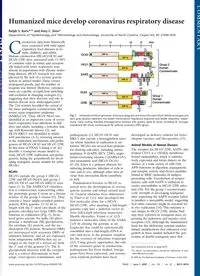
2005 Humanized mice develop coronavirus respiratory disease PDF
Preview 2005 Humanized mice develop coronavirus respiratory disease
Humanized mice develop coronavirus respiratory disease Ralph S. Baric*†‡ and Amy C. Sims* Departments of *Epidemiology and †Microbiology and Immunology, University of North Carolina, Chapel Hill, NC 27599-7435 C oronavirus infections historically were associated with mild upper respiratory tract diseases in in- fants, children, and adults. Human coronavirus (HCoV)-OC43 and HCoV-229E were associated with 15–30% of common colds in winter and occasion- ally linked with lower respiratory tract disease in populations with chronic under- lying diseases. HCoV research was com- plicated by the lack of a reverse genetic system or animal model. These viruses propagated poorly, and the number of reagents was limited. However, coronavi- ruses are capable of rapid host switching and evolution in changing ecologies (1), suggesting that their diversity and role in human disease were underappreciated. The 21st century heralded the arrival of the more pathogenic coronaviruses, like severe acute respiratory syndrome (SARS)-CoV. Then, HCoV-NL63 was identified as an important cause of severe lower respiratory tract infections in chil- dren and adults, including a tentative link- age with Kawasaki disease (2), and HCoV-HKU1 was identified in adults with pneumonia (3–5), renewing interest in the replication mechanisms and patho- genesis of HCoV-OC43 and HCoV-229E. In this issue of PNAS, Lassnig et al. (6) describe a transgenic mouse model to study HCoV-229E replication and patho- genesis, laying the groundwork for devel- oping transgenic mouse models for other HCoVs. HCoVs HCoVs include the group 1 (HCoV- 229E and HCoV-NL63) and group 2 (HCoV-OC43 and HCoV-HKU1) sero- types (3, 4). The SARS-CoV classifica- tion is controversial, representing either the prototype group 4 strain or a distant relative of the group 2 viruses (5). They contain a linear single-stranded positive polarity RNA genome 27–32 kb in length with the 5�-most two-thirds of the genome encoding two large ORFs that function in replication (Fig. 1). Struc- tural genes encode the spike (S) glyco- protein, a membrane (M) glycoprotein, the envelope (E) protein, and the nu- cleocapsid (N) protein. Structural ORFs are interspaced with accessory ORFs of unknown function, and all are expressed from subgenomic mRNAs that are ar- ranged in the form of a nested set from the 3� end of the genome (7). The S glycoprotein interacts with the receptor and is a critical determinant of host range, cross-species transmission, and pathogenesis (1). HCoV-OC43 and HKU1 also encode a hemagglutinin ester- ase whose function in replication is un- known. HCoVs use several host proteins for docking and entry, including amino- peptidase N (hAPN, HCV 229E), angio- tensin-converting enzyme 2 (SARS-CoV), and neuraminic acid (HCoV-OC43) (8–10). Entry is a primary obstacle for initiating productive infection of cells in vitro and in vivo, although other sites of virus–host interaction likely contribute as well. Fundamental barriers to HCoV re- search were the development of reverse genetic systems and robust animal mod- els. Genetic obstacles were obliterated by Thiel et al. (11), who developed the first molecular clone for a HCoV, HCoV-229E, after inserting a full-length genome copy into a poxvirus vector to drive full-length infectious transcripts. Shortly thereafter, Yount et al. (12) isolated a molecular clone of the SARS- CoV by cloning the genome as six fragments that could be systematically assembled into a full-length cDNA in vitro and serve as the genomic template for the recovery of infectious transcripts (12). Using genetic approaches, the role of the accessory genes in coronavirus pathogenesis has been studied, foreign genes have been expressed, and corona- virus replicon particles have been developed as delivery vehicles for heter- ologous vaccines and therapeutics (13). Animal Models of Human Disease The receptor for HCoV-229E, hAPN, also termed CD13, is a 150-kDa membrane- bound exopeptidase, which is constitu- tively expressed and forms dimers on the surface of a wide variety of cells (10). APN functions in digestion, angiogenesis, and synaptic activity and cleaves peptides bound to MHC molecules of antigen- presenting cells. Transfection of nonper- missive cells with hAPN is sufficient to confer susceptibility to HCoV-229E infec- tion (10). For the group 1 coronaviruses, early attempts at developing transgenic mice expressing the hAPN receptor failed to produce a susceptible model, suggesting that other cofactors might be essential for in vivo replication (14). This outcome is not unique to HCoV-229E; similar find- ings were reported in transgenic mice ex- pressing the poliovirus and measles virus receptors (15). Although the fundamental basis for this dichotomy remains undeter- mined, modifications that enhanced virus growth in these models included the gen- eration of double-transgenic mice that See companion article on page 8275. ‡To whom correspondence should be addressed. E-mail:
